PHOENIX – Hours before the final game of the 2017 season, Phoenix College football coach Robin Pflugrad made lunch for his team. The Bears were preparing to host the 8-1 Snow College Badgers, the second best team in the conference.
For lunch, they ate Uncrustables.
Pflugrad and his coaching staff bought the frozen peanut butter and jelly sandwiches in bulk from Costco, and every coach brought a toaster from home to make sure they could efficiently thaw the sandwiches and feed every single player.
The coaches knew that pregame and postgame meals were one of the only ways to make sure every player had enough to eat that day.
“There were several kids homeless,” said Pflugrad, now the assistant head coach at Northern Arizona. “We found some living in their cars.”
With nearly a dozen toasters plugged in, the lights went out. They blew a fuse on campus.
The Bears totaled 676 yards of offense and ran 105 plays that afternoon, but still lost, 64-35.
Just three months later, Phoenix College was told by the Maricopa County Community College District (MCCCD) that its football program, alongside three others governed by the MCCCD, would be cut.
By the end of 2018, there were no junior college football teams in the state of Arizona.
In the years since, a ripple effect has been felt around Arizona’s football scene. Athletes had to either find a new program or throw in the towel on their playing career, while some coaches fought to bring junior college-level football back to the state with a new conference.

When junior college football programs were cut in 2018, Doug Madoski and Steven Weiss sought out to fill the void in Arizona. They say the HJCAC’s partnership with Utah’s Snow College makes it easier for players to simultaneously seek their athletic and educational goals. (Photo courtesy of Cristy Penniman)
Pflugrad originally joined the Phoenix College coaching staff as an offensive coordinator under coach Dan Cozzetto in 2015. Both had been highly regarded assistants at Arizona State and Pflugrad even spent two season as head coach at Montana. They inherited a team on a 20-game losing streak, with a budget often too small to fix chronic problems.
Phoenix College’s home field was nicknamed the “Dust Bowl” – it was used so frequently that blades of grass came in dozens, not thousands. Their uniforms had adidas jerseys and Under Armour pants. Their team colors are navy and gold, but at practice, the Bears wore orange.
“I was wearing an Oregon State practice jersey every practice with somebody else’s last name on it,” C.J. Schrimpf, a former Phoenix College center, said with a nostalgic laugh. “I remember my last name was Robins.”
The Bears were one of eight teams in the Western States Football League (WSFL), seven of which resided in Arizona.
Glendale Community College, Scottsdale Community College, Phoenix College and Mesa Community College fall under the MCCCD; Eastern Arizona College in Thatcher, Pima Community College in Tucson, Arizona Western College in Yuma and Snow College, located in Ephraim, Utah, rounded out the conference.
For years, coaches around the state say they felt pressure from the district and universities wanting to close the doors on football. They say the district cited a lack of financial viability and potential insurance liability, due to the inherent dangers of football as a contact sport.

Players working with Mustangs defensive backs coach Jeremiah McLaurin are enrolled at Utah’s Snow College, which has a partnership with the HJCAC. (Photo by Brooklyn Hall/ Cronkite News)
The Maricopa Athletics Priority Task Force was established in 2012 by the MCCCD, with the goal of examining the viability of various sports. In May 2017, the task force recommended that football programs be eliminated.
That fall, Maria Harper-Marinick, who was then the MCCCD chancellor, sent an email that asserted it was “not prudent to eliminate football,” but that the district would “reevaluate the football programs” in 2018.
On Monday, Feb. 5, 2018, two days before national signing day, the MCCCD notified the schools via email that they’d be shutting down football at all four colleges.
“Ongoing financial constraints, including leveling off of enrollment growth at a majority of the colleges as well as the zeroing out of state support for MCCCD has led to the need for the district to look at the prioritization of resources to ensure we continue to meet the changing educational needs of the community,” the email read.
Mesa Community College athletic director John Mulhern says he and the MCC football team felt blindsided.
“It was disappointing,” Mulhern said. “Because first of all, (we) never had an opportunity to kind of say, ‘This is my input, this is what I think, this is what we can do.’”
The MCCCD could not be reached for comment on the decision.
Once coaches digested the news, they delivered it to their players, many of whom had only just signed. Steven Weiss, a former assistant coach and recruiting coordinator at Scottsdale Community College, gets choked up reminiscing about the moment.
“We had spent the last year putting together a recruiting class, sitting down in homes, talking to parents, talking to student athletes about this wonderful opportunity to come play junior college football in Arizona,” he said. “Ultimately, everything we had told them turned out to be a lie.”
Cozzetto left Phoenix College in 2017 to be an offensive consultant at Oregon State. Watching from afar as the program he worked hard to revitalize collapsed, he felt a mix of regret and helplessness.
Throughout the summer and fall, like dominoes, Eastern Arizona, Pima and Arizona Western announced closures of their programs. By the end of the 2018 fall semester, there were no junior college football programs operating in Arizona.
Local coaches and players say it was hard to deny Arizona’s ability to churn out success stories from the junior college level.
NFL stars like linebacker Fred Carr, a member of the Green Bay Packers Hall of Fame, and punter Jeff Feagles, who still holds the record for most consecutive NFL games played, are products of the MCCCD.
C.J. Schrimpf was a 5-foot-8 offensive lineman during his senior year at Corona del Sol High School in Tempe. He showed up for an open tryout at Phoenix College, made the team and turned his two years of collegiate game tape into a higher opportunity.
Two weeks before his graduation from Phoenix College, Schrimpf said he got a Twitter message from a special teams coach at Coastal Carolina University, offering a preferred walk-on position as a long snapper.

Nicknamed the “Dust Bowl,” Phoenix College’s home field has hosted many junior college football games over the years. (Photo by Grace Edwards/Cronkite News)
“I was two weeks out from graduating and just hanging up the cleats,” he said.
Two weeks later, Schrimpf said he drove 36 hours across the country to Conway, South Carolina, to be a Chanticleer. His gamble paid off – three years later, he was nominated for the 2021 Burlsworth Trophy, given to the most outstanding college football player who started their Division I career as a walk-on.
Schrimpf saw his Chanticleers ranked 12th in the College Football Playoff poll in 2020 and his team won a bowl game at the end of his senior year in 2021. His life changed dramatically after that Twitter message, and Schrimpf says it wouldn’t be possible without the experience gained at the junior college level.
“Because of juco, I ended up leaving college with a completely paid-for associate’s degree, bachelor’s and a master’s degree,” he said.
Quarterback Karé Lyles was under center for the last Scottsdale Community College team to hit the gridiron. The Saguaro High School product tossed 23 touchdown passes that season and earned a position at Southern Illinois, where he started nine games in 2019 and led the Salukis on a five-game winning streak.
Lyles said that many of his teammates at SCC weren’t able to take the next step to Division I but it was because of academic eligibility issues during their final season, not because they lacked the talent to play at the next level.
The quarterback, who redshirted for a season at Wisconsin before playing at Scottsdale, likened the work ethic and ability of his SCC teammates to his former Wisconsin teammates Jonathan Taylor and T.J. Watt, who were ranked fifth and sixth, respectively, in the NFL’s “Top 100 Players of 2022.”
Lyles completed his college career at Jackson State, playing for coach Deion Sanders. Lyles is now working as a production assistant at NFL Network. Looking back, he said he’s frustrated by the stigma that is sometimes attached to junior college football.
“For some reason, there’s an assumption, that if you’re juco, you’re a thug, you’re a bad guy, you did something wrong,” Lyles said. “Not a single one of those guys … are a thug, are a menace to society or are bad guys. They’re great, great humans, and they should have those opportunities.”
In December 2018, less than a year after MCCCD officials announced that football programs would be shut down, 11 athletes filed suit in U.S. District Court against MCCCD, its governing board, each of the board’s individual members and Harper-Marinick, the chancellor.
The players, represented by attorneys Phillip A. Austin and Richard M. Martinez, argued that the district’s reasoning for cutting football programs was flawed, and they alleged that the decision disproportionately impacted African American students.
The suit alleged that elimination of football programs on the district’s campuses would negatively affect 5.8% or 219 out of 3,797 African American students as opposed to .5% or 139 out of 25,796 of white students, according to the complaint.
One of the plaintiffs in the lawsuit, Xavier Juniel, was a freshman wide receiver at Mesa Community College during the final season of the school’s football program. He signed with the Thunderbirds on Feb. 7, 2018, two days after the news came that programs were to be cut.

Mustangs quarterback Cody Lazenby is one of the many players who found a way to keep playing football by turning to junior college competition. (Photo by Brooklyn Hall/ Cronkite News)
After the season ended, Juniel found himself looking for another place to play football. He had been seeking a long-term career in law, and planned to use football as a means of paying for an education. He said the district’s decision threw a wrench into his plans to pursue a career while attending school close to home.
“I was still pretty young,” Juniel said. “I didn’t have anyone really to guide me through that process, so I was kind of just winging it.”
Juniel wound up playing at Riverside City College in southern California for his sophomore season, where his team won the California Community College Athletic Association state championship in 2019.
Juniel has since walked away from football. He’s studying philosophy, politics and law at Northern Arizona, and said transferring junior colleges in the middle of his collegiate football career was a setback that altered the course of his career on and off the field.
“If I would have started at Riverside, as a freshman, instead of in my second year, I think I’d be at a four-year college playing somewhere right now,” Juniel said.
As the process continued, Juniel said he and the plaintiffs could no longer afford the battle and, according to court records, in September 2019 the parties jointly asked the U.S. District Court for the District of Arizona to dismiss the case.
In 2019, Steven Weiss and Doug Madoski, both former coaches at Scottsdale Community College, collaborated to bring junior college football back to Arizona. Together, they founded the Hohokam Junior College Athletic Conference (HJCAC), through the nonprofit Athletic Advancement Association of America (AAAA).
The goal of the HJCAC is to provide junior college level football opportunities for athletes in Arizona who can no longer find that through the MCCCD.
The HJCAC is composed of five teams: the Maricopa Mustangs, Salt River Scorpions, Gila River Hawks, Papago Pumas and Sonoran Sidewinders. The league is not affiliated with the National Junior College Athletic Assocation (NJCAA), but has played games against some of the NJCAA’s top teams, including the New Mexico Military Institute, which won the 2021 NJCAA Division I National Championship.
Home games and practices for HJCAC teams are hosted at high schools around Phoenix, and Weiss, the HJCAC’s executive director, said they’ve emphasized “regionalized” recruiting, where each affiliated team can offer junior college opportunities to a different section of the Valley.
“The best chance (for) you to be able to invite your mom, or your uncle, or your little brother to come out and watch you play college football, is if it’s right down the road,” he said.
In July 2021, the HJCAC announced a partnership with Snow College, the public community college in Utah, and the AAAA, as a way of installing the academic element of junior college football into the conference.
The agreement between the AAAA and Snow College lessened some financial strain on athletes hoping to play junior college football in Arizona. It eliminated a “league fee” that players had to pay in the HJCAC’s first two seasons, if the player was enrolled at Snow College.
As of the time of the announcement, Snow College held an 85% student success rate and 43% graduation rate.
“We knew that if we were going to make something happen, we needed to make it legitimate – it needed to be something that was high integrity when it came to the academic requirements,” Weiss said.
“If we don’t make sure that we secure opportunities for our kids to be successful in school … we’re going to be discredited, and that doesn’t help our students find scholarships.”
Weiss says that even in the HJCAC’s infancy, they’ve had athletes secure scholarships across the Division I football spectrum. He says the conference has focused on growth and reach each year since its foundation, hiring sportscasters, film crews and coaches with varied coaching backgrounds to ensure a feeling of legitimacy surrounds the HJCAC.
“We understand that we are not the destination for anyone – we don’t want to be.” Weiss said. “We want to be a small chapter in a large book of success.”
With the HJCAC, junior college-level football opportunities remain open for Arizona football players hoping to stay in the state. Due to the Snow College partnership, those opportunities can accompany education, too. However, even through the MCCCD, there is still a fight to bring the sport back.
Mulhern said he has been at Mesa Community College for 14 years and has worked under nine different university presidents. With constant turnover, he said MCCCD needs the right combination of leadership to bring football back to the district.
Not long after Mesa Community College appointed current president Dr. Tammy Robinson in July 2022, Mulhern said Robinson approached him as he stood in front of a trophy case honoring the school’s former football program.
She asked how the sport could be brought back and Mulhern said he told her, “It’s up to you.”
“(The HJCAC has) had teams for at least four years now,” he said. “There’s still a demand here.”
Local junior college alumni and coaches say there is a need for the sport in every state, because it offers academic opportunities for athletes who may not be able to secure scholarships at four-year institutions. In the grand scheme of the sport, they believe junior college football can foster growth for even the best of the best.
Current NFL stars such as Green Bay Packers quarterback Aaron Rodgers, New Orleans Saints running back Alvin Kamara and Tampa Bay Buccaneers linebacker Lavonte David are among the players who began their career at a junior college and flourished.
Lyles said that junior college success stories like theirs are the epitome of the American Dream.
“(At) junior colleges, you’re getting it from the bottom,” he said. “Not a lot of people, when they fall in the pit, want to get back up, want to be determined to fight for something. Those guys fight for something – they’re still doing it.”